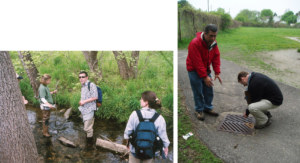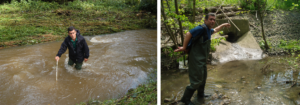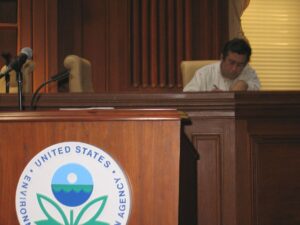It was fifteen years ago, and the meeting conference center meeting room was standing-room only. I took one of the remaining standing spots at the back of the room. Everyone looked expectantly towards the front of room, note books and pens at the ready to write down whatever secret watershed code was to be transmitted from. . .some type of watershed guru? The person who occupied the speaking position happened to be my boss at the time – Tom Schueler. Tom’s demeanor gave me the impression that he would rather be in one of many other places (probably a wooded trail along the Patapsco River) than standing there with a crowd holding onto his every word.
That’s the way he was. Nevertheless, the information he bestowed was valuable and in fact used by countless professionals across the country and world. It was in many ways the source of how to do the craft of watershed protection and stormwater management. Tom had a unique knack for prognosticating the next big thing for an emerging profession, seeming to be years ahead of colleagues in terms of both insight and practical steps to achieve real results. Often, his presentations included a haiku or two, which was bonus material.
Many also recall Tom as the guy we drank beer with before and after every training event, and, in the old days, showing up to said events with mussed up hair and his shirt buttoned in unique asymmetrical arrangements.
The rowdiness of the wardrobe, however, belied an underlying professional discipline that Tom adhered to and urged his staff to follow. Each meeting had an agenda and started and ended on time. Teamwork among staff working on a project was not left to chance, but orchestrated with detailed workplans. This was essential in order to pull off the task of writing a watershed manual or hosting a week-long retreat.
As for those weeklong retreats, the Center for Watershed Protection hosted many watershed and stormwater retreats. Attendees would come from far and wide and were immersed in a carefully crafted (but seemingly informally run) array of classroom and field sessions. There was also the hang-out time, which served to build the professional community, another objective to which Tom dedicated his life’s work. Tom once commented to me that his intention for these retreats was that they would serve as career-altering or defining events for the attendees – not a small ambition, but one that I believe was experienced by most who made the journey.

Left: Tom instructs Watershed Institute particpants on the Unifed Stream Assessment (USA). Right: Tom could made urban stormdrains a topic of fascination as he instructs the Unified Subwatershed & Site Reconnaissaince (USSR) method. The USA & USSR methods combined stream channel and uplands into a watershed assessment framework. Photos: Anne Kitchell collection of CWP archival photos.
Tom’s retirement marks a generational shift in the watershed and stormwater world. In many ways, Tom’s work dating back to the 1980s defined the professional as a practical and achievable pursuit tied to scientific findings.
Many of us who have been around for several decades can recall being hunched over the “Green Book” (Controlling Urban Runoff: A Practical Manual for Planning & Designing Urban BMPs), which Tom authored in 1987 while working at the Metropolitan Washington Council of Governments. We’d study the text and cartoonish graphics of bioretention, infiltration, permeable pavement, and other practices and immediately want to try it out in our own jurisdictions. Later, we’d anticipate the monthly installment of Watershed Protection Techniques newsletter reporting the latest science and innovative work going on in the field.

Left: Tom nearly overtops the waders demonstrating how to measure the stream thalweg. Right: Simply put, Tom loved discovering stormwater outfalls. Photos: Anne Kitchell collection of CWP archival photos.
Then came the watershed and stormwater manual era, and we frankly have lost count of how many manuals were produced when Tom led the Center for Watershed Protection. A favorite was the one about stormwater retrofits, where you could learn how to become a stormwater detective, exploring parking lots, urban ditches, and manicured suburban yards for opportunities to plug in some stormwater management.
A couple examples of Schueler memorabilia from T-shirts (left) and beer glasses (right). Graphics: Anne Kitchell collection of CWP archival photos.

Tom loves roaming the watershed, but his career also had an outsized influence on regional, national, and even international approaches to watershed protection. Photo: Anne Kitchell collection of CWP archival photos.
Tom founded the Chesapeake Stormwater Network in 2009 to bring his skills close to home as the Chesapeake Bay Program was going through many formative stages of restoration and regulation.
Tom cares about the people he works with and their careers. I count myself among the fortunate to have experienced his leadership, guidance, and friendship. I suppose the prognosticating, meeting agendas, and expert panel reports are behind him at this point, and he is probably saying “good riddance” to it all, but not without a wistful nod back. We all wish Tom many years ahead of trail walking, camping in the dunes, hanging out with friends and colleagues, reading poetry, and maybe just gazing out at the water.
With Gratitude, David J. Hirschman, [email protected]
Many thanks to my many wonderful colleagues who share more Tom stories and reflections than could possibly fit within a simple blog post.

